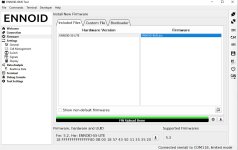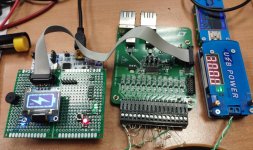JohnGalt171
100 µW
- Joined
- Feb 2, 2022
- Messages
- 8
This is excellent! I've been looking for something like this for quite a while.
Does anyone know of an equivalent project for high voltage MPPT? (up to 600-900V solar in, and 120S battery?)
And anyone know of an equivalent project for high voltage Pure Sine Wave Inverter that is parallelable and will scale with battery voltage?
And AC/DC Charger for backup?
What my ultimate goal is, is to use this on basically a LiFePO4 Powerwall, that can scale over time. I.e. I have 64 batteries right now but will get it up to 120/124 as I have funds. This is ideal because I can just add another slave controller and viola, more power. But without the MPPT that can handle that, it becomes really difficult to create a complete configuration. I've honestly thought about building my own dual stage GanFET design for it but I'd rather someone with more EE do the design and I'll do the software.
And then there is the inverter. Sadly, lots of stuff can't be run from DC (although lots can just accept DC if you give it the right voltage which is a lot easier with 384VDC from the battery available because that just happens to work well with most DC inverter high power devices like heat pumps etc.)
It seems like the approach for this BMS is ideal for both of these, because tapping 12V from the battery pack to power them means that you can scale the battery size nicely and the solar input size without having to worry about deriving the voltages necessary for the controller and fets etc. from the full voltages. Same for the inverters. In both cases it means that you can scale without issue. The pure sine wave inverter would be slightly more difficult, but is really just a GanFET H-Bridge with the right software doing PWM with the right time slices and an inductor. The trick is parallelizing slave units from the central controller to scale the Wattage available, but using this same design as the BMS, it seems very doable just using a feedback circuit to sync the PWM to the existing signal.
The last component of such a system would be a DC EV charger with boost/buck support so that you didn't need to use the costly inverters with all of the waste that that entails to charge your EV and instead could use DC and of course a scalable voltage and amperage AC/DC charger for backup charging from the grid and then software to intelligently power the DC bus this creates from the various sources based on charge state, weather forecasts, current solar input and EV charge state. (i.e. you want to only use AC charging from the grid as a backup, but you want to never run out and want to opportunistically charge when rates are lowest during the day and support remote turn off like some states have for AC charging which means an algorithm that understand weather, usage, and charge states to identify when and how much AC charging will be required and where to shunt power.
As an aside, it would be ideal to have a 24S version of the slave controller which I believe the chip handles, because then a 120S 384V pack nominal for LiFePO4 is just 5 slaves and you can buy in 24s.
I'm a casual EE designer and have done some of my own boards etc. But I'm a very good computer programmer and am comfortable with C/Arduino/C#, PWMing with 180 degree out of phase for half bridges, etc. and with Flutter for building apps and code to manage all of this and have built an IOT platform that is serverless but allows IoT devices to interoperate using mDNS discovery, identity certificates (that are issued into esp32s at time of adoption), and WebRTC. If I can help out some expert EE people and we can get something going to build a POC with open source free to use for personal use and licensed for commercial use and resale with some great software across all 6 platforms that builds out all of these components, I'd love to talk to everyone that's interested and get this going.
Does anyone know of an equivalent project for high voltage MPPT? (up to 600-900V solar in, and 120S battery?)
And anyone know of an equivalent project for high voltage Pure Sine Wave Inverter that is parallelable and will scale with battery voltage?
And AC/DC Charger for backup?
What my ultimate goal is, is to use this on basically a LiFePO4 Powerwall, that can scale over time. I.e. I have 64 batteries right now but will get it up to 120/124 as I have funds. This is ideal because I can just add another slave controller and viola, more power. But without the MPPT that can handle that, it becomes really difficult to create a complete configuration. I've honestly thought about building my own dual stage GanFET design for it but I'd rather someone with more EE do the design and I'll do the software.
And then there is the inverter. Sadly, lots of stuff can't be run from DC (although lots can just accept DC if you give it the right voltage which is a lot easier with 384VDC from the battery available because that just happens to work well with most DC inverter high power devices like heat pumps etc.)
It seems like the approach for this BMS is ideal for both of these, because tapping 12V from the battery pack to power them means that you can scale the battery size nicely and the solar input size without having to worry about deriving the voltages necessary for the controller and fets etc. from the full voltages. Same for the inverters. In both cases it means that you can scale without issue. The pure sine wave inverter would be slightly more difficult, but is really just a GanFET H-Bridge with the right software doing PWM with the right time slices and an inductor. The trick is parallelizing slave units from the central controller to scale the Wattage available, but using this same design as the BMS, it seems very doable just using a feedback circuit to sync the PWM to the existing signal.
The last component of such a system would be a DC EV charger with boost/buck support so that you didn't need to use the costly inverters with all of the waste that that entails to charge your EV and instead could use DC and of course a scalable voltage and amperage AC/DC charger for backup charging from the grid and then software to intelligently power the DC bus this creates from the various sources based on charge state, weather forecasts, current solar input and EV charge state. (i.e. you want to only use AC charging from the grid as a backup, but you want to never run out and want to opportunistically charge when rates are lowest during the day and support remote turn off like some states have for AC charging which means an algorithm that understand weather, usage, and charge states to identify when and how much AC charging will be required and where to shunt power.
As an aside, it would be ideal to have a 24S version of the slave controller which I believe the chip handles, because then a 120S 384V pack nominal for LiFePO4 is just 5 slaves and you can buy in 24s.
I'm a casual EE designer and have done some of my own boards etc. But I'm a very good computer programmer and am comfortable with C/Arduino/C#, PWMing with 180 degree out of phase for half bridges, etc. and with Flutter for building apps and code to manage all of this and have built an IOT platform that is serverless but allows IoT devices to interoperate using mDNS discovery, identity certificates (that are issued into esp32s at time of adoption), and WebRTC. If I can help out some expert EE people and we can get something going to build a POC with open source free to use for personal use and licensed for commercial use and resale with some great software across all 6 platforms that builds out all of these components, I'd love to talk to everyone that's interested and get this going.



